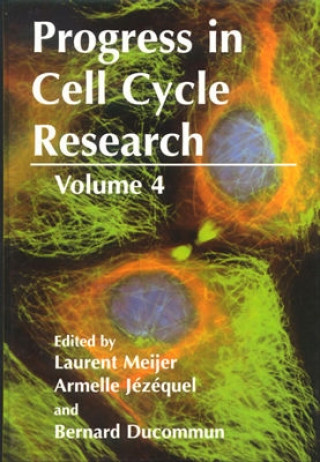
Kézbesítés
Vásárlási tanácsadó
16 105 015 könyv 175 nyelven








Összes nyelv megjelenítése (175)





Nem vált be? Semmi gond! Nálunk 30 napon belül visszaküldheti
 Ajándékutalvány
bármilyen értékben
Ajándékutalvány
bármilyen értékben
Ajándékutalvánnyal nem nyúlhat mellé. A megajándékozott az ajándékutalványért bármit választhat kínálatunkból.
Progress in Cell Cycle Research. Vol.4
 Angol
Angol
 279 b
279 b
30 nap a termék visszaküldésére
Ezt is ajánljuk


The Progress in Cell Cycle Research series is dedicated to serve as a collection of reviews on various aspects of the cell division cycle, with special emphasis in less studied aspects. §This fourth volume of Progress in Cell Cycle Research starts with a review of RAS pathways and how they impinge on the cell cycle (chapter 1). In chapter 2, an overview is presented of the links between cell anchorage - cytoskeleton and cell cycle progression. A model of the G1 control in mammalian cells is provided in chapter 3. The role of histone acetylation and cell cycle control is described in chapter 4. Then follow a few reviews dedicated to specific cell cycle regulators: the 14-3-3 protein (chapter 5), the cdc7/Dbf4 protein kinase (chapter 6), the two products of the p16/CDKN2A locus and their link with Rb and p53 (chapter 7), the Pho85 cyclin-dependent kinases in yeast (chapter 9), the cdc25 phosphatase (chapter 10), RCC1 and ran (chapter 13). The intriguing phosphorylation-dependent prolyl-isomerization process and its function in cell cycle regulation are reviewed in chapter 8. Our current knowledge of the molecular mechanisms of cell cycle regulation has greatly benefited from the use of oocyte maturation, a unique but diverse cellular process investigated in a large variety of models reviewed in chapter 11. The cross-talks between MAP kinase and cdc2/cyclin B in oocytes have been particularly well understood in Xenopus (chapter 12). More and more data show the interference of viral proteins with the mammalian cell cycle (see review in chapter 1 of Progress in Cell Cycle Research !). One such example, the HTLV-1 tax protein, is described in chapter 14. Our knowledge of the cell cycle is spreading to protozoan parasites, as nicely reviewed in chapter 15, and this may have great therapeutic consequences. Quite fascinatingly, the cell cycle is regulated by the circadian rhythm, from unicellular organisms (chapter 16) to man (chapter 17). The use of cell-cycle-specific treatments in cancer therapy may greatly benefit from understanding and use of the links between the cycle and the rhythm. Major advances have been recently made in the identification of the molecular actors regulating the circadian rhythm. We anticipate that some cell cycle and circadian rhythm regulators will soon be found to be connected. The treatment of cancer (and other cell-cycle-related diseases) will also obviously benefit from a better understanding of the connections between cell cycle and apoptosis (chapter 18). As more and more `cell cycle drugs' are being discovered, their use as anticancer drugs is being extensively investigated; they are reviewed in chapter 19. The discovery of cell cycle regulators in the brain of Alzheimer's disease patients leaves us with the idea that cell cycle studies, initially supported by the antitumour purpose, may have applications in quite unexpected fields.
Információ a könyvről
 Angol
Angol




 Hogyan vásároljunk
Hogyan vásároljunk
























